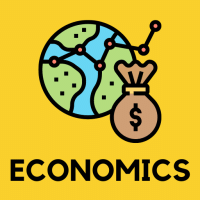Commerce Exam > Commerce Questions > It is possible to have a real exchange rate a...
Start Learning for Free
It is possible to have a real exchange rate appreciation and a nominal exchange rate depreciation atthe same time.
- a)True
- b)False
Correct answer is option 'A'. Can you explain this answer?
Verified Answer
It is possible to have a real exchange rate appreciation and a nominal...
Yes, a nominal exchange rate depreciation is a decrease in E. If at the same time, domestic prices are increasing much faster relative to the foreign prices, then P/P∗ could increase to swamp the decreasein E so that ε = EP/P∗ increases, i.e., a real exhange rate appreciation.
Most Upvoted Answer
It is possible to have a real exchange rate appreciation and a nominal...
Real Exchange Rate Appreciation vs. Nominal Exchange Rate Depreciation
Real exchange rate appreciation and nominal exchange rate depreciation can occur simultaneously due to differences in inflation rates between two countries.
Real Exchange Rate Appreciation
- Real exchange rate is the nominal exchange rate adjusted for price levels in both countries.
- Real exchange rate appreciation occurs when a country's goods and services become relatively more expensive compared to another country.
- This can happen when the inflation rate in one country is lower than in another, leading to a lower rate of increase in prices.
Nominal Exchange Rate Depreciation
- Nominal exchange rate is the price of one currency in terms of another currency.
- Nominal exchange rate depreciation happens when the value of a currency falls relative to another currency.
- This can occur due to various factors such as changes in supply and demand for the currency, economic conditions, and market speculation.
Simultaneous Real Appreciation and Nominal Depreciation
- When a country's inflation rate is lower than that of its trading partners, its real exchange rate appreciates.
- At the same time, if the nominal exchange rate of the country's currency falls relative to its trading partners, it results in nominal exchange rate depreciation.
- Therefore, it is possible to have a situation where there is a real exchange rate appreciation and a nominal exchange rate depreciation occurring concurrently.

|
Explore Courses for Commerce exam
|

|
Question Description
It is possible to have a real exchange rate appreciation and a nominal exchange rate depreciation atthe same time.a)Trueb)FalseCorrect answer is option 'A'. Can you explain this answer? for Commerce 2025 is part of Commerce preparation. The Question and answers have been prepared according to the Commerce exam syllabus. Information about It is possible to have a real exchange rate appreciation and a nominal exchange rate depreciation atthe same time.a)Trueb)FalseCorrect answer is option 'A'. Can you explain this answer? covers all topics & solutions for Commerce 2025 Exam. Find important definitions, questions, meanings, examples, exercises and tests below for It is possible to have a real exchange rate appreciation and a nominal exchange rate depreciation atthe same time.a)Trueb)FalseCorrect answer is option 'A'. Can you explain this answer?.
It is possible to have a real exchange rate appreciation and a nominal exchange rate depreciation atthe same time.a)Trueb)FalseCorrect answer is option 'A'. Can you explain this answer? for Commerce 2025 is part of Commerce preparation. The Question and answers have been prepared according to the Commerce exam syllabus. Information about It is possible to have a real exchange rate appreciation and a nominal exchange rate depreciation atthe same time.a)Trueb)FalseCorrect answer is option 'A'. Can you explain this answer? covers all topics & solutions for Commerce 2025 Exam. Find important definitions, questions, meanings, examples, exercises and tests below for It is possible to have a real exchange rate appreciation and a nominal exchange rate depreciation atthe same time.a)Trueb)FalseCorrect answer is option 'A'. Can you explain this answer?.
Solutions for It is possible to have a real exchange rate appreciation and a nominal exchange rate depreciation atthe same time.a)Trueb)FalseCorrect answer is option 'A'. Can you explain this answer? in English & in Hindi are available as part of our courses for Commerce.
Download more important topics, notes, lectures and mock test series for Commerce Exam by signing up for free.
Here you can find the meaning of It is possible to have a real exchange rate appreciation and a nominal exchange rate depreciation atthe same time.a)Trueb)FalseCorrect answer is option 'A'. Can you explain this answer? defined & explained in the simplest way possible. Besides giving the explanation of
It is possible to have a real exchange rate appreciation and a nominal exchange rate depreciation atthe same time.a)Trueb)FalseCorrect answer is option 'A'. Can you explain this answer?, a detailed solution for It is possible to have a real exchange rate appreciation and a nominal exchange rate depreciation atthe same time.a)Trueb)FalseCorrect answer is option 'A'. Can you explain this answer? has been provided alongside types of It is possible to have a real exchange rate appreciation and a nominal exchange rate depreciation atthe same time.a)Trueb)FalseCorrect answer is option 'A'. Can you explain this answer? theory, EduRev gives you an
ample number of questions to practice It is possible to have a real exchange rate appreciation and a nominal exchange rate depreciation atthe same time.a)Trueb)FalseCorrect answer is option 'A'. Can you explain this answer? tests, examples and also practice Commerce tests.

|
Explore Courses for Commerce exam
|

|
Signup for Free!
Signup to see your scores go up within 7 days! Learn & Practice with 1000+ FREE Notes, Videos & Tests.























